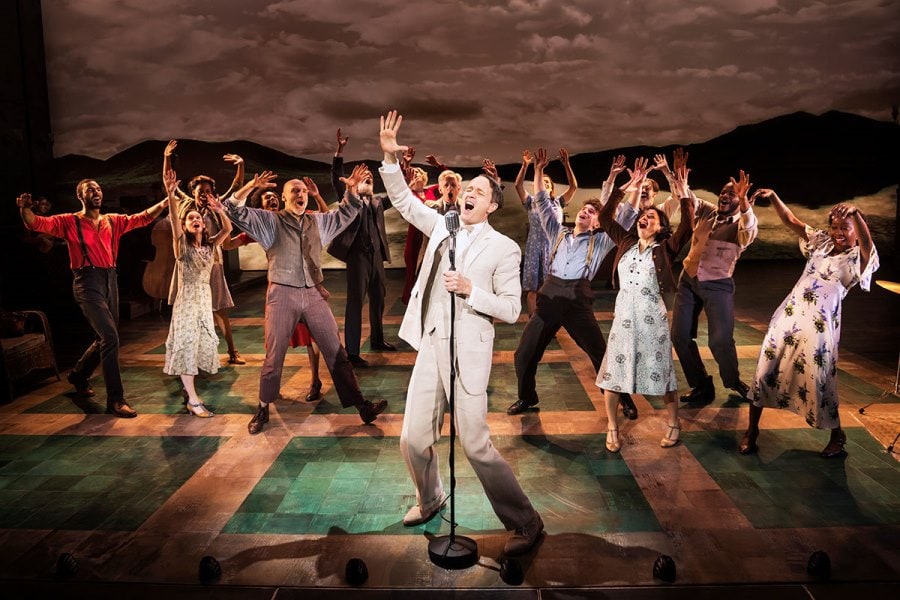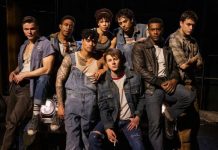In Girl from the North Country, playing an open engagement at Broadway’s Belasco Theatre following successful runs in London and Off-Broadway at The Public Theater, Irish playwright and director Conor McPherson examines the personal impact of the Great Depression through the universal emotions inherent in Bob Dylan’s songs and thirteen characters whose fraught lives intersect in 1934, at a tumbledown boarding house in Duluth, Minnesota (the Midwestern town where Dylan was born in 1941). It’s an anachronistic pairing that presents a new approach to the rampant genre of the jukebox musical, albeit one that doesn’t always gel. But when it does, it evokes an uplifting sense of the power of music to give voice to our feelings, thoughts, and dreams and to free our souls – even if only while singing.

The mélange of songs, stories, and figures – a pastiche of borrowings from such iconic American authors of the period as John Steinbeck, Thornton Wilder, Ernest Hemingway, and Eugene O’Neill – is introduced and interspersed with commentary by the local Doctor Walker (played by Robert Joy), a narrator who looks back on the characters’ struggles and inter-relationships during the darkest of economic times (with shades of Our Town, and even more so at the conclusion). At the center is the near-bankrupt proprietor Nick Laine (portrayed by Jay O. Sanders), his dementia-stricken (or is it feigned?) wife Elizabeth (Mare Winningham), widowed lover Mrs. Nielsen (Jeannette Bayardelle), pregnant adoptive daughter Marianne (Kimber Elayne Sprawl), and heavy-drinking son Gene (short for Eugene, as in O’Neill), who just happens to be an aspiring writer (Colton Ryan).
These familiar Depression-era archetypes (or have they become stereotypes?) are joined by the denizens who pass through the boarding house: a recently incarcerated boxer named Joe Scott (Austin Scott); a shady Bible salesman calling himself Reverend Marlowe (Matt McGrath); and a strained couple, Mr. and Mrs. Burke (Marc Kudisch and Luba Mason), caring for their adult developmentally-impaired son Elias (Todd Almond). We also meet two neighbors: the aged Mr. Perry (Tom Nelis), intended by Nick to marry the decades-younger expectant Marianne; and the no-nonsense Kate Draper (Caitlin Houlahan), the object of Gene’s affection, who opts for a more stable partner.
Each of McPherson’s sundry figures faces overwhelming adversities, with odd touches of over-the-top sardonic humor that reek of cornpone, and occasional comments (as when Marianne denounces Mr. Perry as a “predator”) and general attitudes (the women’s behavior is often unapologetically feisty and empowered) that feel distinctly post-modern, even though the costumes and set (by Rae Smith) evince the 1930s. He also has the characters make some questionable, but eminently believable, decisions and self-defeating responses to their financial hardships – stealing, drinking, scamming, fighting, flaunting their infidelity, and withdrawing from reality – rendering them not always likeable, but all-too human. A standout in the cast is Austin Scott, who brings empathy, three-dimensionality, and control to his well-written, soft-spoken, and put-upon character Joe, even when he’s pushed to the point of physical confrontation and possible rejection.

The most rousing highlights of the show are the 21 Dylan songs (encompassing such classics from the ‘60s as “I Want You,” “Like a Rolling Stone,” and “All Along the Watchtower,” popular hits and lesser-known works of the ‘70s-‘90s, and “Duquesne Whistle,” co-composed with Robert Hunter in 2012) interposed as breakaways between the backstory narratives, which punctuate the plot points (at least tangentially) and powerfully reveal the emotional experiences and moods that we, along with the characters, have all felt and share. Performed in a variety of American styles that bring a different sound to the originals – including everything from blues and love ballads to gospel and revivalist, country-western and rock (orchestrations, arrangements, and musical supervision by Simon Hale; music direction by Marco Paguia) – they are marked by consistently superb vocals, rich harmonies, and spirited heartfelt deliveries by the entire cast. Among the most hauntingly evocative and affecting are solos by Scott, Bayardelle, Winningham, and Almond, and the joyous group numbers by the entire ensemble, with lively dancing and movement (by Lucy Hind) and lighting (by Mark Henderson) that casts dark shadows and silhouettes or glows a blinding white, depending on the tone of the music.
The Broadway production of McPherson’s Girl from the North Country is more like a patchwork quilt than a finely woven tapestry. While it sometimes seems clashingly disparate in its stitched pieces, it ultimately comes together in a celebration of Dylan’s poetic and expressive songs that are so beautifully arranged and emotively performed, and to which we can all relate.
Running Time: Approximately two hours and 25 minutes, including an intermission.
Girl from the North Country plays an open-ended run at the Belasco Theatre – 111 West 44th Street, NYC. For tickets, call (212) 239-6200, or purchase them online.





